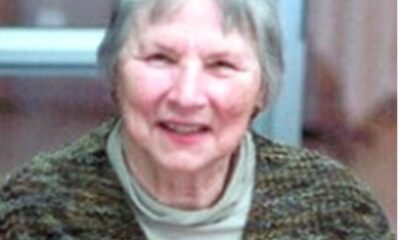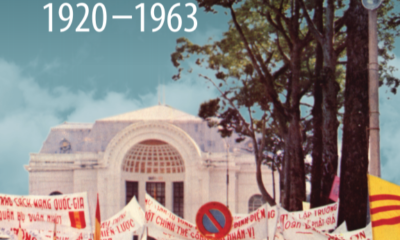Society & Culture
Library Development In the Republic of Vietnam Before April 30, 1975
Published on
By
Lam Vinh The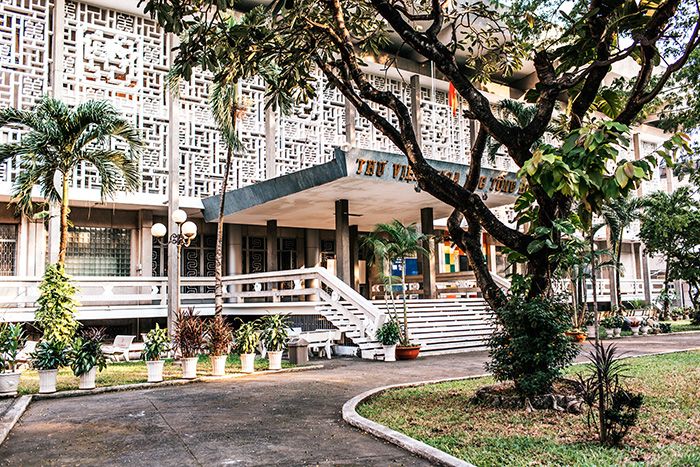
Editor’s Note: The following text is based on research compiled by Vinh-The Lam and serves as a historical record for the development of the public library system in the Republic of Vietnam. Edits have been kept to minimal to conform to the journal’s stylistic guidelines.
This text relies heavily on the author’s recollection, as official documents and data pertaining to the Republic of Vietnam (RVN) are currently unavailable or, at best, difficult to access. Fortunately, a substantial collection of Thư Viện Tập San (English translation: Library Journal), the official publication of the Vietnamese Library Association (VLA), published before April 30, 1975, remains accessible. Consequently, the author possesses valuable information on the development of libraries in South Vietnam. The author earnestly welcomes corrections and updates from readers.
Pre-1967 Period
Before 1967, the library system of the RVN was relatively weak in every aspect, from the numbers of libraries, physical facilities and collections to the available human resources. The VLA’s Thư Viện Tập San, in its special issue of 1960, could list only 30 libraries, public and private, for the whole country (25 in South Vietnam, and 5 in Central Vietnam) as follows:
- public libraries: 4
- academic libraries: 6
- special libraries: 5
- government libraries: 5
- private libraries: 2
- foreign libraries: 8
The most striking characteristic of this period was the fact that the library development was not based on any pre-conceived planning. The main reason was the lack of leadership in both public and private domains, namely from the National Library of Vietnam (NLV) and the VLA, which did not have any policy for the library development for the RVN.
The public library system was almost non-existent in South Vietnam. In addition to the NLV, located at no. 34 Gia Long Street (with a collection of 70,000 books and some 600 periodical titles) and the Tổng Thư Viện (in English: General Library; it used to be the Indochinese Library in Hanoi, which was moved to Saigon after the signing of the Genena Accords in July 1954, and had a collection of 3,000 books and 110 journal titles), located in the Petrus Trương Vĩnh Ký High School area (most of the so-called public libraries in the provinces and regional municipalities just served as information or reading rooms with totally insignificant collections of books and periodicals. Luckily, the people of the Capital city of Saigon, were quite well served by the three following foreign libraries:
- The Abraham Lincoln Library, a unit of the USIS (United States Information Service), located in downtown Saigon, next to the Rex Movie Theater, in front of the City Hall; it was later relocated to no. 8 Lê Quý Đôn Street, and finally to the inside of the compound of the Vietnamese-American Association at no. 55 Mạc Đĩnh Chi Street, in District 1 of Saigon; this Library had a collection of around 10,000 volumes of books and 210 periodical titles in English, and some books in French and Vietnamese as well.
- The Library of the French Cultural Mission, located next to the well-known French Grall Hospital, at no. 31 Đồn Đất Street, with a collection of some 20,000 volumes of books and periodicals in French language.
- The Library of the Alliance Française, located at no. 22 Gia Long Street, close to the intersection with Tự Do Street
These three libraries all had excellent physical facilities, with spacious reading rooms equipped with air-conditioners, and having good collections which attracted a quite large number of college and senior high school students.
While the public library system was that poor, the special library system was, on the contrary, relatively stronger and possessed a large number of government and research libraries. Almost all government ministries had a library, and the most important was the Library of the Ministry of Information located on Phan Đình Phùng Street. For research libraries, the most important ones were: 1) The Library of the Archeological Institute, first located at No. 7 Nguyễn Bĩnh Khiêm Street, in front of the Saigon Zoo, then relocated a few times with its final destination on Gia Long Street, had a collection of 15,000 books on history, geography (including numerous rare 19th-century gazetteers compiled under the Nguyễn Dynasty), sociology, a large number of old manuscripts in Nôm characters, and a sizable collection of periodicals and microfilms [1] ; 2) The Library of the Société des Études Indochinoises, located inside the Saigon Museum; and 3) The Library of the École française d’Extrême-Orient located at no. 37 Trương Minh Ký Street.
For academic libraries, each university had its own library. Right in Saigon, the capital city, among the public universities, i.e., the faculties directly under the jurisdiction of the University of Saigon, each had a library located in a small room and with an insignificant collection. The only higher-educational institution that had a real academic library was the Institute of National Administration (INA). Its library was housed in a quite spacious building with a very large and good collection of books and periodicals because the INA was directly receiving financial and technical support from Michigan State University, with a US-educated librarian, Mrs. Tăng Thị Tị, who had a Master of Library Science (MLS) from Peabody College, a library school accredited by the American Library Association (ALA). Among the group of private universities, the Buddhist Vạn Hạnh University, which received strong and steady financial support from the Asia Foundation, had the best academic library located in a very large building with an excellent collection of books and journals in both Vietnamese and English languages. This library also had two librarians, both having an MLS, a female monk named Trí Hải, and Ms. Phạm Thị Lệ-Hương, who later, in 1974-75, held the position of Treasurer within the VLA’s Executive Committee. In the provinces there were the libraries of Huế, Đà Lạt and Cần Thơ Universities but their collections were quite poor.
The school library system was also very weak. Only a few high schools had libraries; the elementary schools did not have any library. In Saigon, the four large high schools, Petrus Ký, Chu Văn An, Gia Long and Trưng Vương, all had libraries, which, unfortunately, were merely storage rooms for textbooks, which were loaned out to students at the beginning of school years; these “libraries” did not have either reading or reference rooms. There was one exception and that was the case of the Library of the Thủ Đức Demonstration High School. This special high school was built with financial aid from the United States Agency for International Development (USAID) through Ohio University, which provided technical and professional support. Most of its teachers and one librarian were granted scholarships to go to the U.S. for their professional training. Its librarian, Mr. Nguyễn Ứng Long, graduated from Peabody College, in the state of Tennessee, with an MLS. (Mr. Nguyễn Ứng Long was later, in 1970, nominated, by the Goverrnment of the Republic of Vietnam –GVN–, Director of the Directorate of Archives and National Library, in Vietnamese: Giám Đốc Nha Văn Khố và Thư Viện Quốc Gia).
A great majority of people working in the library field during this period, including the so-called librarians, were not professionally trained. The few cases like Mrs Tăng Thị Tị and Mr. Nguyễn Ứng Long were the rare exceptions.
It was indeed strange but fortunate, however, in terms of professional documents, there were quite a few valuable books widely used by library workers for a really long period of time: 1) Cataloging and classification of books = Phương pháp tổng kê và phân loại sách compiled by Mr. Richard K. Gadner, a member of the advisory team from Michigan State University, and translated into Vietnamese by Mrs. Nguyễn Thị Cút, Library Assistant, United States Information Service (USIS); 2) Lưu trử hồ sơ (English translation: Document archiving) by Mr. Nguyễn Hùng Cường; and 3) Mục lục phân tích tạp chí Việt ngữ, 1954-1964 (English translation: Index of Vietnamese-language periodicals, 1954-1964) compiled by Ms. Trần Thị Kim Sa. The first book was published with financial support from the Asia Foundation in two editions, the first edition in 1959 and the second one in 1966. The First edition was bilingual (English-Vietnamese) with an appendix of almost 300 pages being the text of the Dewey Decimal Classification in three languages: English, French, and Vietnamese. The second edition was only in Vietnamese, and its Appendix, still being the Dewey Decimal Classification, was just bilingual (English-Vietnamese). Both the second and the third books were published by the INA in 1965.
1967-1973 Period
The special characteristic of this period was that the library development began to be planned. Reason: the creation of the Library Development Agency (LDA) as a unit of USAID. The advisor overseeing the LDA was Mr. John Lee Hafenrichter, who had two Vietnamese assistants, Mrs Lưu Chiêu Hà, and Mr. Nguyễn Tĩnh Thuật. Later Mr. Hafenrichter also secured the assistance of Ms. Lê Thu Nguyệt, who had acquired some professional library training in Australia.
The LDA had an action program with concrete objectives for three fields: 1) In terms of physical facilities, to achieve a library system for the RVN that included all types of libraries, namely public, school, academic, and special libraries, forming a pyramid-like complex with the national library on top; 2) In terms of human resources, to train a pool of professional library workers that included two streams: lower- and intermediate-level workers to be trained in Vietnam, and high-ranking professionals to be educated in the US; and, 3) In terms of standardization, translation , and publication of library training materials, to provide all library workers with access to the materials in order to achieve unity of library terms, cataloging code and classification system. In 1968, Mr. Hafenrichter had a talk at the RVN’s Ministry of Culture, Education, and Youth on the objectives of library development for Vietnam. In 1969, at the occasion of the inauguration of the Cultural Week in Vĩnh Long, Mr. Hafenrichter came and spoke of the influence of school libraries upon the subjects taught in schools, with a focus on the role of high school libraries in the curriculum support and the improvement of instructional methods.
Library System
Within the library system, the top priority was given to school libraries. This decision was made based on the rapid growth of education in South Vietnam in spite of the increasing level of the war. During the 10-year period (from school year 1957-58 to school year 1966-67), the total number of students (kindergarten, elementary and high schools) has grown from1,011,355 to 2,264,479, i.e., more than 100%. The total number of high schools (including junior high and senior high schools) has increased from 363 (school year 1958-59) to 644 (school year 1966-67), with the total number of senior high schools growing from 78 to 267 (from Directory of National Statistics of the RVN). During this period of time, the Ministry of Education has also decided to expand nation-wide the application of comprehensive high education. A number of existing high schools in the provinces were selected to transform into comprehensive high schools. A delegation of principals of those selected high schools was sent to the US in mid-April 1967 for observation and learning from the experiences of the American comprehensive high schools. Later, the Ministry has ordered some brand new comprehensive high schools to be built, such as the Nguyễn An Ninh (for boys) and Sương Nguyệt Anh (for girls) schools in Saigon, and the Chưởng Binh Lễ school in Long Xuyên, etc.[2] Of course, all these comprehensive high schools had libraries with adequate physical facilities and significant collections. All regular high schools were instructed by the Directorate of Secondary Education to reserve spacious rooms to set up libraries. At around the beginning of the 1970s, a large number of high schools (both regular and comprehensive) in South Vietnam had good libraries, the total of which was estimated at around 100. It was a very significant development. Following are some statistics of school library development in South Vietnam:
- For the training of lower-level library workers, during 1968-1971, the LDA in cooperation with the Directorate of Secondary Education, has organized a total of 12 training courses for the following numbers of high school teacher-librarians:
1968: 4
1969: 22
1970: 28
1971: 20
Total: 74
After the LDA was gone (after the withdrawing of USAID from the RVN in accordance with the signed Paris Accords in January 1973), the Directorate of Secondary Education was successful in organizing 2 basic training courses in Summer 1973 (with 38 participants) and Summer 1974 (with 40 participants), thus, increasing o total number of trained high school teacher-librarians to 152 (74 + 38 + 40 = 152). For the training of intermediate-level library workers, the Đại Học Sư Phạm Sài Gòn (English translation: Faculty of Pedagogy of Saigon University) has organized 2 training one-year courses during the 2 school years of 1972-1973 and 1973-1974, with 25 participants for each course, all of them being senior high school teachers. In addition, in Summer 1972, 11 teachers from a number of high schools and normal schools were selected by the Ministry to be sent to Australia for professional library training.
- In terms of collection development, in addition to the local funds provided by provincial governments, the LDA also made significant financial contributions to buy books, periodicals, and even instructional materials for the school libraries as follows:[3]
Year Vietnamese Books English Books
1967 350,000 VN Đồng 28,000 USD
1968 500,000 – 12,000 –
1969 3,000,000 – 12,000 –
1970 2,300,000 – 11,000 –
1971 5,000,000 – 20,000 –
1972 6,000,000 – 25,000 –
1973 7,000,000 – 25,000 –
1974 7,000,000 – 30,000 –
Total 31,150,000 – 163,000 –
According to Mr. Lê Ngọc Oánh (a graduate from the Master of Library Science Program at Kansas State Teachers’ College, in Emporia, Kansas, USA), a library specialist from the Directorate of Secondary Education, directly responsible for every aspect (planning, budgeting, equipment providing, inspection) of the school library development program of the Directorate, the following high schools had the best school libraries: Gia Long High School (in Saigon) with Ms. Lê Khắc Ngọc Mai as librarian; Vũng Tàu High School (in Vũng Tàu) with Mr. Nguyễn Duy Hy as librarian; and, Nguyễn Trung Trực High Schol (in Rạch Giá) with Mr. Nguyễn Nhựt Quang as librarian.
During this period of time, just like the secondary education, the higher education system was also developing very rapidly. The total number of college and university students has increased from 4,364 (school year 1957-58) to 32,393 (school year 1966-67), i.e., almost 800% (data from Directory of National Statistics of the RVN). For public institutions, in addition to the two universities of Saigon and Huế, the government created in 1966 a new one in Cần Thơ for the Western provinces of the Mekong Delta. For private institutions, after the establishment of Đà Lạt University in 1958, a series of private, or rather religious, universities were created: Vạn Hạnh (Buddhist, 1964), Minh Đức (Catholic, 1970), Cao Đài (in Tây Ninh, 1971), and Hòa Hảo (in An Giang, 1971). From 1972 onward, the government also established several community colleges, such as Tiền Giang Community College (in Mỹ Tho), Duyên Hải Community College (in Nha Trang), and Quảng-Đà Community Colleges (in Đà Nẵng).[4] All of the higher educational institutions had libraries. However, as previously mentioned, most of them (excepted the the INA and Vạn Hạnh University libraries) were housed in inadequate physical facilities and had quite poor collections. During this period of time, fortunately, the Library of the Faculty of Medicine, Saigon University, was an exception. With the exceptional financial assistance from the American Medical Association (AMA), this academic library was administered by a series of professionally-trained American librarians: Mrs Eleanor Johnson (from August/1967 to June/1969), Mr. John I. Patton, Jr. (from June/1969 to June/1972), and Mr. Thomas Cassidy (September/1972 to July/1974). For the period June-August 1972, Dr. Nguyễn Đức Nguyên, former Secretary-General and then Special Assistant to the Dean, Faculty of Medicine, Saigon University, was nominated Director of the Faculty of Medicine Library. Under Dr. Nguyên’s leadership, the Medical Library had some good developments. In July/1973, this Library got a new professionally-trained Librarian, Ms. Nguyễn Thị Nga, a graduate from the Library School of University of North Carolina-Chapel Hill. Ms. Nga, together with Mr. Cassidy, put in place the standards for cataloging and circulation for this Library. At the beginning of 1974, the Medical Library already had a collection of 16,355 books and more than 300 periodical titles.[5]
In the area of public libraries, the Directorate of Archives and National Library already had a plan to build a new National Library. The building of the new National Library, located at no. 69 Gia Long Street, had the first stone laid by Prime Minister Trần Văn Hương on December 28th, 1968.[6] Before the new building of the National Library was inaugurated, Mr. Nguyễn Ứng Long, Director of Archives and National Library, had successfully approached the Asia Foundation for the funding of two big projects. The first big project was to furnish the National Library’s Card Catalog Room with all required US-made standard card catalog cabinets approved by the American Library Association. These cabinets have been in use until the end of the 20th century when information technology became popular and the card catalog was replaced by the OPAC (Online Public Access Catalog). The second big project was to build a microfilm production room for the National Library. The Asia Foundation contacted the Kodak Company’s Singapore Office. The Kodak sent a representative to Saigon to introduce its products and Mr. Nguyễn Ứng Long himself selected the one he believed responding exactly to the needs of the National Library. Just like the case of the first project, the Asia Foundation took care of all steps in this project from contract signing to equipment paying. According to this contract, Kodak had to train National Library staff, and thus, before the machine was delivered and installed in a room on the first floor of the National Library, one staff was sent to Singapore for 3-month training. This new physical facility of the National Library had a 14-floored building with the capacity of storing up to one million volumes, with spacious and air-conditioned Reading Room, Reference Room satisfying international standards, and was solemnly inaugurated on December 23rd, 1971 by President Nguyễn Văn Thiệu.[7] During the time of construction of the National Library, the Directorate of Archives and National Library has organized in early 1971 one training course for the library staff and some staff of other Ministries as well. In addition, with the coordination and support from the LDA, the Directorate of Archives and National Library has also put in place a 10-year plan to send to the US 10-12 people for Master and 1-2 for Ph.D. in Library Science training. The first employee of the National Library to se sent to the US for MLS training was Ms. Trần Thị Thuần. M Nguyễn Ứng Long has also decided to change the form of name entries for Vietnamese authors in the national bibliography. In the past, in the national bibliography, the inverted form of name entries for Vietnamese authors was used as follows:
- Linh, Nguyễn Ngọc
- Thiện, Phạm Công
This usage was not in accordance with the prevailing Vietnamese custom, which has always called authors by Family Name, NOT Given Name. For the national bibliography, therefore, Mr. Nguyễn Ứng Long has decided that the form of name entries for Vietnamese authors should follow the prevailing Vietnamese custom:
- Nguyễn Ngọc Linh
- Phạm Công Thiện
This decision was one step closer to the Anglo-American Cataloging Rules, Second Edition (AACR2, 1967), which required the following entries:
- Nguyễn, Ngọc Linh
- Phạm, Công Thiện
Going hand in hand with that decision, Mr. Nguyễn Ứng Long has also made the decision to publish the Retrospective National Biblliography of Vietnam in three languages Vietnamese-English-French:
- Thư tịch hồi tố quốc gia Việt Nam = Retrospectibe national bibliography of Vietnam = Bibliographie nationale retrospective du Vietnam
This retrospective national bibliography was for the period 1936-1967, and was published by Phủ Quốc Vụ Khanh Đặc Trách Văn Hóa (English translation: The State Secretariat Responsible for Cultural Affairs) in 1971, and included 4 volumes as follows:
- Volume 1: 1963-1967
- Volume 2: 1954-1963
- Volume 3: 1945-1954
- Volume 4: 1936-1945
This retrospective national bibliography provided a continuation to the Bibliographie de l’Indochine (1913-1935) compiled by Paul Boudet. (All of these data were provided to the author of this article by Mr. Nguyễn Ứng Long himself in his emails of 6-Jan-2007, 7-Feb-2007, and 17-Feb-2007). At the same time, the Directorate of Archives and National Library also had a plan to disband the General Library located on the campus of the Petrus Ký High School and merge its collection into the collection of the new National Library under construction. The public library system development, which was being well in good progress, came to a sudden halt because of the government’s decision in 1972 to cut the Directorate of Archives and National Library into two separate units: The Directorate of National Archives (English translation: Nha Văn Khố Quốc Gia) and The National Library (given status of a directorate). Mr. Nguyễn Ứng Long was made Director of the Directorate of National Archives, and Mr, Phan Văn Hữu, the Head Librarian of Cần Thơ University Library, was nominated Director of National Library. The public library system lost an extremely competent and dedicated leader and its development made no more progress until the fateful day of April 30, 1975. After 1975, Mr, Nguyễn Ứng Long emigrated to France, and passed away on September 22, 1018. He would be forever missed by his family, friends and colleagues in the library field.
In the area of special libraries, the Library of the Archeological Institute was relocated from its old place near the Saigon Zoo to its new location on Gia Long Street, but its Librarian was still Mr. Đỗ Văn Anh, a very competent and experienced librarian well respected by Viet study researchers inside and outside Vietnam. Another significant development in the area of special libraries was the creation of several military libraries needed by the war efforts. Two of these military libraries were having great physical facilities and excellent collections: 1) The Library of Trường Võ Bị Đà Lạt (English translation: Đà Lạt National Military Academy); and 2) The Library of Trường Cao Đẳng Quốc Phòng (English translation: The War College). The Đà Lạt Military Academy Library was headed by Lieutenant Phan Đình Công, with an MLS, and a classmate of the author of this article at the Library School of Syracuse University, New York, USA, 1971-1973. The War College Library was supervised by Lieutenant Hoàng Ngọc Hữu, who later became Commissioner for Special Libraries of the Executive Committee of the VLA, 1974-1975.
Training of Library Staff
2.21. Lower-Level Library Staff
The LDA has organized several basic library training courses at its office located at no. 1 Thống Nhứt Boulevard, right in front of the Saigon Zoo. Most participants were teachers from elementary and secondary schools, who had been assigned to work in their school libraries. The author of this article, himself, was one of those participants. Every year, the LDA organized 4 training courses, which lasted 3 weeks, with Mr. Hafenrichter as the principal instructor, and with Mrs. Lưu Chiêu Hà as the translator. Each course included only around 10 participants.[8,9] After the training course, each participant was given a copy of the book entitled Phương pháp tổng kê và phân loại sách (English translation: Methods of cataloging and classification of books) to be uses in his/her library work. A number of good participants working in the Saigon area and having a good command of English were invited by Mr. Hafenrichter to participate in the translation of English library documents into Vietnamese. Thanks to this training program, executed continuously for 5 years, at the beginning of 1973, most school librarians already had some basic knowledge of library science. After the Paris Accords were signed at the end of January 1973, the LDA was ordered to close shop. Its work was taken over by the Directorate of Secondary Education, which already had two library specialists trained overseas: Mr. Lê Ngọc Oánh with an MLS from Kansas State Teachers’ College in the US, and Mr. Đoàn Huy Oánh, with a library diploma from Australia. The Directorate of Secondary Education has organized several basic library training courses in Saigon, modelled on the LDA’s courses. In the provinces, the Directorate, in collaboration with the Education Zones (created from October 1972 in accordance with the National Administrative Reform [10]), also organized many such training courses. The author of this article, himself, has taught some of these basic library training courses in Saigon and in Vĩnh Long.
2.22. Intermediate-Level Library Staff
Now, as the lower-level library staff serving in school libraries (mostly high schools, both general and comprehensive) and having graduated from basic library training courses organized by the LDA and the Directorate of Secondary Education has already reached a sizable pool, the Faculty of Pedagogy of Saigon University, with the approval of the Ministry of Education, has decided to organize one-year intermediate-level training courses. Participants to these courses should be volunteers, who met the following qualifications: 1) Having already graduated from the Faculty of Pedagogy’s 4-year program, i.e., Senior High School Teachers; 2) Having finished at least 2 years of teaching; and, 3) Having completed one basic library training course provided by the LDA or the Directorate of Secondary Education. This training course had 25-26 participants and was taught by instructors with MLS from American library schools. After completion of this training course, participants will automatically get to the next grade in their senior high teacher classification. The Faculty of Pedagogy was able to offer 2 such training courses. The author of this article, himself, has taught the second one (school year 1973-1974). When this training course was announced there were too many qualified applicants and the Faculty of Pedagogy had to select them based on their seniority in their classification. It turned out, therefore, that for both courses the participants all had quite high numbers of years of teaching. When I was involved in the teaching of the second course (1973), two of the participants happened to be my classmates, who had graduated with me from Section History-Geography at the Faculty of Pedagogy in 1963: Ms. Đặng Thị Thảo and Mr. Cao Đình Vưu.
2.23. High-Level Library Staff: Professional Librarians
The LDA has also set up a project for the training of high-level library staff for the RVN. The objective of this project was to train 30-40 professional librarians with Master’s degree and 2-3 with a Ph.D. in Library Science. All of them should already have completed the undergraduate program in Vietnam and should have a good command of English as required by American universities (specifically, they must have completed the TOEFL (Test of English as a Foreign Language) with at least a 550 score. They would be receiving scholarships from USAID for their 2-year study in the US at an ALA-accredited library school’s Master of Library Science program (ALA = American Library Association). Most participants came back to Vietnam after their graduation. Following is a list of these people (alphabetically by their given names, that I still remember):
- Mr. Tôn Thất Viễn Bào, Huế University
- Lt. Phan Đình Công, Đà Lạt National Military Academy
- Mr. Đỗ Viết Cửu, Cần Thơ University
- Mr. Tống Văn Diệu, National Library
- Ms. Phạm Thị Lệ-Hương, Vạn Hạnh University
- Mr. Phan Văn Hữu, Cần Thơ University, later becoming Director of National Library
- Mr. Trần Chính Liên, Faculty of Pedagogy, Saigon University
- Mr. Trần Anh Liển, National Library
- Ms. Mai Thị Nhung, National Library
- Mr. Lê Ngọc Oánh, Directorate of Secondary Education, Ministry of Education
- Mr. Phan Hoàng Quý, Huế University
- Mr. Lâm Vĩnh-Thế, Thủ Đức Demonstration High School, later Head Librarian, Faculty of Pedagogy, Saigon University
- Mr. Trần Văn Thông, Quảng-Đà Community College
- Ms. Trần Thị Thuần, National Library
- Ms. Đào Thúy, Faculty of Pedagogy, Saigon University
According to the LDA’s plan, 2-3 people among the group of people with MLS and after having served 2 years in Vietnam, would be selected and sent back to the US for a Ph.D. program. The event of April 30, 1975 prevented that ambitious plan from being implemented.
Preparation and Publication of Professional Documents
With its abundant financial resources, the LDA was able to make several important contributions in the standardization of library services for the RVN. Mr. Hafenrichter was helpful in assembling a number of participants graduating from these basic library training courses provided by the LDA to form a group of assistants to help him in the translation, compilation, and publication of several library documents. The people who made most contributions in these activities were: Mr. Hồ Văn Dõng (Kiến Phong High School), Mr. Nguyễn Văn Hường (Nguyễn Đình Chiểu High School in Mỹ Tho; later becoming Secretary-General of the VLA), Mr. Nguyễn Văn Thước (Hùng Vương High School in Đà Lạt, one of my classmates at Faculty of Pedagogy, Saigon University, 1960-1963), Mr. Nguyễn Nhựt Quang (NguyễnTrung Trực High School, Rạch Giá), and Mr. Nguyễn Ngọc Hoàng (replacing me at Thủ Đức Demonstration High School; later becoming Commissioner for Planning, Executive Committee of the VLA).
The library documents produced by the LDA were:
- Danh từ thư viện và những danh từ chọn lọc trong các lãnh vực liên hệ, Vietnamese translation of ALA glossary of library terms with a selection of terms in related fields / Elizabeth Thompson, published by the American Library Association (ALA) in 1943. The Vietnamese translation, in Ditto, was published in April-1973, 30 pages.
- Tự điển thư viện học (English translation: Dictionary of library science), a mimeographed document, published in September-1973, 126 pages, with a bilingual (English-Vietnamese) index, pp. 99-126.
- Bột quy tắc tổng kê Anh-Mỹ (Anglo-American cataloging rules), also a mimeographed document, published in 1973.
During this period of time, the VLA was also reactivated (please read more in the later section on the VLA’s activities) and has published a few important professional documents as follows:
- Niên giám thư viện = Directory of libraries, 1970.
- Niên giám thư viện tại Việt Nam = Directory of libraries in Vietnam / compiled by Nguyễn Thị Cút, 1973.
- Tiểu dẫn về tổ chức và hoạt động Hội Thư Viện Việt Nam (English translation: Entry on organization and activities of the Vietnamese Library Association), 1971.
- Tổ chức và điều hành thư viện (English translation: Organizing and administering a library), compiled by Nguyễn Thị Cút and Lê Thị Lệ-Chi, 1971.
- Thư viện cho mọi người, Vietnamese translation of Libraries for all by Martha T. Boaz, translated by Nguyễn Thị Cút, Hồ Văn Quang and Nguyễn Ứng Long, 1971.
- Cách tìm sách trong thư viện (English translation: How to find books in libraries).
- Tiêu đề môn loại (English translation: Subject headings), 1973.
- Thư Viện Tập San (English translation: Library Journal) was published again on a regular basis from June 1, 1968, called New Series, as a quarterly.
1974-1975 Period
The characteristic of this period was the planned development of the VLA helping the library field gain an important position in the cultural activities of the RVN and making a very good contribution to the library development for the RVN, especially in the areas of human resource training and professional standardization.
Vietnamese Library Association (VLA)
The VLA was officially created by Decree no. 709/BNV/K3 of the Ministry of the Interior, Government of the RVN (GVN), on December 12, 1958. At its First Annual Meeting of December 12, 1959, the Central Executive Committee was elected with a membership as follows:[11]
- President: Mr. Phan Vô Kỵ, Head, Service of Archives, National Library
- Vice-President: Mr. Nguyễn Gia Phương, Deputy Director, Directorate of Archives and National Library
- Secretary-General: Mr. Hoàng Tuấn Anh, Librarian, Ministry of Information and Youth
- Treasurer: Mr. Ngyễn Công Tạo, First Class Secretary, Directorate of Archives and National Library
- Commissioner for Planning: Ms Trần Thị Kim Sa, Librarian, INA
- Commissioner for Social Affairs: Ms. Nguyễn Thị Cút, Deputy Director, USIS Library
- Commissioner for Organization: Mr. Nguyễn Ngọc Tám, Secretary-General, Faculty of Sciences, Saigon University
- Commissioner for Finances: Mr. Kiều Hữu Hoành, Head, Office of Archives, Directorate of Archives and National Library
The VLA was successful in grouping a number of people, mostly civil servants, working in the libraries of their agencies, and some people outside the library field as well. The Special issue (1960) of its official organ, Thư Viện Tập San, also published a list of its membership that included 82 members (with 43 working in libraries, and 39 working outside the library field). A number of members working in the library field have taken one of the two courses called “lớp tu nghiệp công chức về lưu trữ công văn và quản trị thư viện” (English translation: In-service training course in archival conservation and library management) organized by the Ministry of National Education for civil servants working in various directorates and agencies of all ministries (the total number of participants of the two courses was 90 people, 57 for the course of 1956 and 33 people for the course in 1957). It is safe to mention that the majority of these library workers were still continuing the old tradition from the French domination era: libraries were just storage rooms for books, totally in closed stacks, and having no reference services at all. The readers just searched for what they needed in the card catalog cabinets, wrote down the books’ information, handed the slips to library staff, who went to the stacks to get the books for them; the readers were never allowed to search the books on the shelves where the books are shelved by accession numbers and by sizes, not by subjects and classification numbers. Every year, the VLA met only once at its Annual Meeting to elect the Central Executive Committee. Its professional activities were extremely limited.
The period 1960-1963, i.e., the last years of the First Republic of Vietnam, because of the political difficulties encountered by the GVN, the VLA did not have any significant activity. After the November 1, 1963 military coup overthrowing the Ngô Đình Diệm regime, the VLA was facing even more difficulties caused by the retirements (or forced retirements) of too many members, especially those in the Central Executive Committee (all of them were high-ranking civil servants, probably also members of the Cần Lao Party, which was dissolved and banned after the coup; and readers should also remember that Mr. Ngô Đình Nhu, younger brother and Political Advisor of President Ngô Đình Diệm, was also Honorary President of the VLA.[12]), leading to a temporary suspension of the VLA that lasted until 1968.
The VLA was reactivated in 1968 but, for the next 3 years, it continued the unfortunate path of low-profiled action program of the previous years: the only two visible activities of the VLA were: 1) to organize the Annual Meeting for the election of a new Executive Committee, and, 2) luckily, to continue to publish the regular quarterly Thư Viện Tập San:
1968 and 1969 Terms: [13]
President: Ms. Đặng Phương Nghi
Vice President: Mr. Nguyễn Văn Toán
Secretary-General: Mrs. Bùi Thị Mỹ Chân
Treasurer: Ms. Phạn Mỹ-Linh
Commissioner for Planning: Mr. Nguyễn Hùng Cường:
Commissioner for Organization: Mr. Nguyễn Ứng Long
Commissioner for Finances: Mrs. Nguyễn Thị Cút
Commissioner for Social Affairs: Ms. Đào Thúy
1970 Term: [14]
President: Mr. Nguyễn Văn Toán
Vice-President: Mrs. Nguyễn Thị Cút
Secretary-General: Mr. Nguyễn Văn Thu
Assistant Secretary-General: Mr. Đặng Ngọc Thiềm
Treasurer: Ms. Phan Mỹ-Linh
Assistant Treasurer: Ms. Lê Thị Lệ-Chi
Commissioner for Planning: Mr. Nguyễn Ứng Long
Commissioner for Organization: Mr. Ngô Văn Cách
Commissioner for Finances: Mrs. Nguyễn Thị Thiều
Commissioner for Social Affairs: Mr. Nguyễn Văn Vinh
Comm. for School Libraries: Mrs Lưu Chiêu Hà
1971 Term: [15]
President: Mrs. Nguyễn Thị Cút
Vice-President: Mr. Nguyễn Ứng Long
Secretary-General: Mr. Nguyễn Văn Thu
Assistant Secretary-General: Ms. Nguyễn Thị Phương-Nguyệt
Treasurer: Ms. Chu Chính-Tâm
Assistant Treasurer: Ms. Lê Thị Lệ-Chi
Commissioner for Planning: Mrs. Hoàng Thị Kim-Loan
Commissioner for Organization: Mr. Lâm Vĩnh-Thế
Commissioner for Finances: Mr. Nguyễn Văn Vinh
Commissioner for Social Affairs: Ms. Lê Thu Nguyệt
Comm. For School Libraries: Mrs. Lưu Chiêu Hà
Counsellor: Mr. Nguyễn Văn Toán
Mrs. Nguyễn Thị Cút was re-elected President for the next two years (1972-1973). During this period of time, for the first and only time, the VLA was able to establish a branch in Huế. The first Huế Branch President was Mr. Phan Hoàng Quý (1970) [16] the second President was Mr, Nguyễn Cửu Sà (1973); Huế Branch was very successful with quite a few significant achievements.[17]
The VLA Executive Committee now began to establish special interest committees with the active participation of US-educated librarians having MLS, such as Mr. Nguyễn Ứng Long, Ms. Đào Thúy, Ms. Phạm Thị Lệ-Hương, Mr. Lê Ngọc Oánh. The graduates from training courses organized by the LDA, mostly senior high school teachers with college degrees, also became VLA’s members and began to make contributions by writing articles for the Thư Viện Tập San. The author of this article, himself, also began to publish in that VLA’s professional journal, before and after his 2-year study in the US at the School of Library Science, Syracuse University, New York.[18,19,20]
At the beginning of 1974, the author of this article was elected President of the new Executive Committee of the VLA with the following membership:
1974 Term: [21]
President: Mr. Lâm-Vĩnh-Thế
Vice-President: Mr. Trần Anh Liễn
Secretary-General: Mr. Nguyễn Văn Hường
Treasurer: Ms. Phạm Thị Lệ-Hương
Assistant Treasurer: Mrs. Nguyễn Thị Khuê-Giung
Commissioner for Planning: Mr. Nguyễn Ngọc Hoàng
Commissioner for Finances: Mr. Nguyễn Văn Vinh
Commissioner for School Libraries: Mr. Lê Ngọc Oánh
Comm.for Academic and Special Libraries: Ms. Nguyễn Thị Nga
Commissioner for Communications: Mr. Đoàn Huy Oánh
Commissioner for Social Affairs: Ms. Đặng Thị Thảo
Board of Counsellors: Mrs. Nguyễn Thị Cút, Mr. Nguyễn Hùng Cường,
Mr. Đỗ Văn Anh, and Mr. Nguyễn Văn Thu
This was the first time since its creation in 1958, the VLA has elected to the positions of President, Vice-President and Treasurer three members, who were all professional librarians with Masters’ degrees in Library Science from US ALA-accredited library schools. Another characteristic of this Executive Committee was that a great majority of the Committee’s membership were young people under 40, who have graduated from library training courses. The Board of Counsellors included experienced people with very high seniority in the profession. This Executive Committee did not let VLA members down, and, in fact, has achieved very important developments for the profession in the RVN in general and for the Association in particular.
Development of the Vietnamese Library Association
3.21. Office for the Vietnamese Library Association
At the first meeting of the VLA’s Executive Committee for 1974 term, an important issue was presented and needed to be resolved: where the office of the VLA should be located? In the past, for many years, the office of the Association was located inside the compound of the Hội Việt-Mỹ (English translation: Vietnamese-American Association = VAA) at no. 55 Mạc Đĩnh Chi Street, in District 1, Saigon. The reason: Mrs. Nguyễn Thị Cút, VLA’s President, was Head of the Abraham Lincoln Library, also located within the area of the VAA. The VLA’s new Executive Committee believed that the VLA should not continue to be located there any more. Ms. Phạm Thị Lệ-Hương, VLA’s new Treasurer, was working as Assistant to the Dean of the Faculty of Social Sciences of Vạn Hạnh University, and at the same time also Deputy Head of its Library Responsible for the Secular Collection of the Library, suggested that the VLA’s office be located in Vạn Hạnh University campus. She also volunteered to go see the University Rector, Venerable Thích Minh Châu, to negotiate for the issue. And she succeeded: Venerable Minh Châu agreed to allow the VLA to have its office within Vạn Hạnh campus, more specifically in the headquarters of the Faculty of Social Sciences, at no. 222 Trương Minh Giảng, District 3, Saigon. When the LDA was disbanded after Jan-1973, its collection of books and journals was donated by Mr. Hafenrichter to the VLA and stored in Vạn Hạnh Library and would be used in the training courses organized by the VLA later.
3.22. VLA’s Activities During 1974 Term
It was also at that first meeting that the Executive Committee has discussed and unanimously approved a very ambitious action program including the following projects: 1) To publish 4 issues of the quarterly Thư Viện Tập San and the monthly Bản Tin (English translation: Bulletin or Newsletter); 2) To organize 2 free basic library training courses for members; 3) To organize a Summer Meeting to discuss a number of professional issues and some internal affairs as well; 4) To improve membership control; and, 5) To publish a number of professional documents.
The author of the article, as President of VLA, wrote the Letter from the President for the first issue of the Bản Tin as follows: [22]
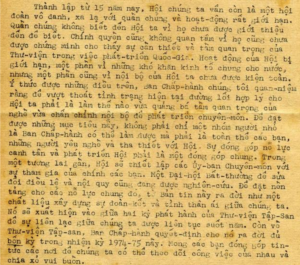
English translation:
“Created 15 years ago, our Association is still an anonymous association, very unfamiliar to the people, and with very limited activities. The people are not aware of our Association because it has not been introduced to them. The government is also not interested because it has not been demonstrated the necessity and importance of our Association in the development of our country. The activities of our Association are limited, in part because of the general economic difficulties of the country, but, in part, because of our internal weaknesses. Being completely conscious of these issues, we, the Executive Committee, believe that, in order to escape from this difficult situation, the most logical policy for our Association must be twofold: to widely publicize the importance of our profession and to resolve our internal weaknesses for professional development. In order to achieve these two objectives, it is not possible for a small number of people of the Executive Committee that can do it, but it should be that all members of VLA, who love the profession and cherish the Association, to do it. The contributions in the innovation and development of the Association must be our common efforts. A special Summer Meeting to take care of our internal problems is being considered and planned. In order to lay a good foundation for these efforts, this Bản Tin is published to help build our unity and our camaraderie. It will appear regularly between two consecutive issues of the Thư Viên Tập San so that our connection could be continuous throughout the whole year. As for the Thư Viện Tập San, we decided to publish 4 issues for this 1974 term. We hope that you would be able to make contributions with news from all over the country so that we can follow closely our activities, and share among us all joys and sorrows.”
In order to have enough financial resources to carry out this ambitious action plan, the Executive Committee has prepared a detailed Project of Activities and submitted it to the Asia Foundation for funding. The Asia Foundation approved the Project and provided funds for all activities planned in the Project. The Executive Committee was able, therefore, to achieve all objectives for 1974 action plan.
3.221. Thư Viện Tập San and Bản Tin
Four issues of the Thư Viện Tập San, from no. 20 (1st Quarter 1974) to no. 23 (4th Quarter 1974), were published and sent to all VLA members all over the country, from Huế in the North to An Xuyên (Cà Mau) in the South. Following are some typical articles:
- Lâm Vĩnh Thế, Thư viện cổ Alexandria (English translation: The Ancient Library of Alexandria) in no. 20, pp. 3-12
- Nhật Thịnh and Nguyễn Thị Khuê-Giung, Đai cương những tên hiệu Việt Nam xưa và nay (English translation: General introduction to Vietnamese pseudonyms now and then), in no. 20, pp. 23-24.
- Nguyễn Văn Hường, Sử dụng học sinh phụ tá tại thư viện (English translation: Utilization of student assistants in libraries), in no. 21, pp. 14-28.
- Lê Ngọc Oánh, Tiến trình phát triển thư viện học đường Việt Nam hiện đại (English translation: Evolution of school library development in contemporary Vietnam), in no. 21, pp. 38-51.
- Nguyễn Xuân, Văn khố Viêt Nam thời Pháp thuộc và những di sản văn hóa triều Nguyễn (English translation: Vietnamese archives under the French domination era and the cultural heritage of the Nguyễn Dynasty), in no. 22, pp. 17-42.
- Lê Tấn Tài, Cách tổ chức hồ sơ xếp đứng trong thư viện học đường (English translation: Method of organizing vertical files in school libraries), in no. 22, pp. 43-52.
- Lê Bá Kông (Phạm Thị Lệ-Hương, translator), Kỹ nghệ xuất bản sách tại Việt Nam (Eglish translation: Book publishing industry in Vietnam), in no. 23, pp. 17-32.
- Lâm Vĩnh-Thế, Chương trình C.I.P. là gì? (English translation: What is C.I.P. Program?), in no. 23, pp. 45-50.
For the period between the two consecutive issues of Thư Viện Tập San, 7 issues of Bản Tin were also published and distributed to all members to inform them on the planned projects (for example: the 1974 Special Summer Meeting) and concrete activities of the Executive Committee, both internal and external (for example: preparations for election to the Hội Đồng Văn Hóa Giáo Dục (English translation: Council of Culture and Education = CCE, one of the 3 national councils created by the 1967 Constitution of the RVN and presided over by the Vice-President of the Republic).
3.222 Basic Library Training Courses
Implementing the action program already planned, the Executive Committee of the VLA has organized two free basic library training courses for members in 1974. The first course was organized in May 1974 (from May 7 to June 28) with 31 participants, and the second one in September 1974 (from September 23 to November 13) with 30 participants. The courses, each comprising 120 hours of instruction, were taking place in Vạn Hạnh University Library, and instructional staff were members of the VLA’s Executive Committee and the Board of Counsellors. The training program included the following topics: 1) History of Libraries; 2) Organization and management of Libraries; 3) Cataloging and Classification; 4) Reference Services. During the courses, participants were also given trips to visit important libraries in the Capital City of Saigon. The opening and closing ceremonies of the courses were solemnly organized in Auditorium 19 (the largest auditorium) of Vạn Hạnh University, and presided over by both the Deputy Minister of Culture and Education Responsible for Cultural Affairs and the Vice-Rector of Vạn Hạnh Unversity. At the closing ceremonies, all participants were presented with certificates of graduation. After the closing ceremonies, tea-parties were offered in the university cafeteria. At these opportunities, invitation cards were sent to all public and private cultural organizations and agencies in Saigon, and, thanks to this action, the position of the VLA among these cultural organizations and agencies was pretty much elevated.
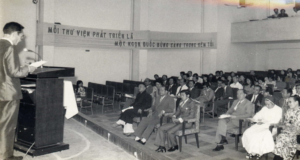
Dr. Bùi Xuân Bào, Deputy Minister of Education Responsible for Cultural Affairs
delivering his speech at Opening Ceremony of Training Course
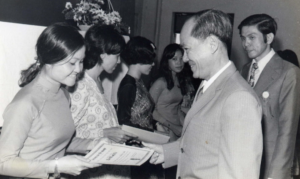
Dr. Nguyễn Ngọc Huy, Rector of Saigon University, presenting certificates
of graduation to participants of Training Course
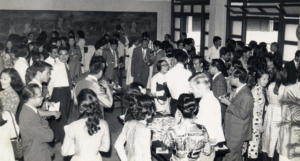
Tea party after Closing Ceremony of Training Course in Vạn Hạnh University cafeteria
3.223 1974 Summer Meeting
It was the first time ever that the VLA has organized a special meeting called 1974 Summer Meeting. The Meeting lasted 3 days from August 9 to August 11. The purpose was to provide an opportunity for all members to discuss and resolve a number of internal affairs. This Meeting was prepared vey carefully by the Executive Committee. Four Special Committees were created with responsibility to prepare discussion papers for the Summer Meeting as follows:
- Classification Committee:
- Chair: Mr. Lâm Vĩnh-Thế
- Secretary: Mr. Nguyễn Ngọc Hoàng
- Members: Ms. Nguyễn Thị Phương Nguyệt, Mr. Đỗ Văn Anh, and Mr. Nguyễn Văn Vinh
- Caloging Committee:
- Chair: Ms. Nguyễn Thị Nga
- Members: Ms. Phạm Thị Lệ-Hương, Mrs. Bùi Tuyết Nhung, and Mr. Hoàng Ngọc Hữu
- By-Laws Committee:
- Co-Chairs: Mr. Nguyển Cửu Sà and Mr. Lâm Vĩnh-Thế
- Secretariat: Mr. Nguyễn Nhựt Quang, Mr. Trần Thanh Sao, and Mr. Lê Văn Thu
- Panelists: Mr. Lê Ngọc Oánh, Mr. Nguyễn Hùng Cường, and Mr. Hoàng Ngọc Hữu
- School Library Status Committee:
- Chair: Mr. Lê Ngọc Oánh
- Secretariat: Mr. Nguyễn Nhựt Quang, and Mr. Nguyễn Văn Thước
- Panelists: Ms. Đặng Thị Thảo, and Ms. Huỳnh Thị Oanh
These committees were given the following responsibilities:
- Classification Committee: To prepare the Dewey Decimal Classification number table for Vietnamese History, Geography, and Literature
- Cataloging Committee: To resolve the issue of Main Entry for Vietnamese Authors
- By-Laws Committee: To amend the Charter and Internal Regulations based on the current situation and development of the VLA
- School Library Status Committee: To prepare and recommend a Decree-Law for the official status of school librarians
These four Special Committees had weekly meetings in April and May 1974. Recommendations from them were discussed by the Executive Committee in the 2 meetings of June 29 and July 4. They were then sent to all members to study one month before the Summer Meeting. The Executive Committee also contacted the two Directorates of Elementary Education and Secondary Education of the Ministry of Culture and Education asking them to grant permissions to travel and approve per diems for school librarians so that they could attend the Summer Meeting in Saigon. In some cases of members living in far away places, like Huế, Đà Nẵng, Cà Mau, free air tickets were given to them. The Summer Meeting was a stunning success with the participation of almost 300 members (in the past, at annual meetings to elect the Executive Committee, the number of participants has never been more than 100) and all objectives of the 4 Special Committees were achieved, with the most significant being the Official Status of School Librarians.[23]
3.224 Correcting the Internal Situation of Membership
Right from the beginning of 1974 term, the VLA’s Executive Committee was aware that the total number of members was over 400. But in reality, never were there more than 100 actually involved in the Association’s activities. In addition, more than 200 members did not pay annual fees (200 VN Đồng / year), among them there were people who still owed their fees for 2-3 years, even 6-7 years. The fact was that the VLA had lost a very high sum of legitimate income. After having discussed the issue, the Executive Committee has reached the final resolution that the situation had two main reasons: 1) From the members’ point of view, because in the past the Association did not provide them with any benefit, they did not see why they had to pay the annual fees; 2) From the Association’s point of view, the Association also had not perform well its duty in following up and reclaiming the annual fees owed by members. Ms. Phạm Thị Lệ-Hương, VLA’s Treasurer, has submitted an action plan to recover the income loss. The Bản Tin was used to implement this action plan. On the one hand, members were shown very clearly all the benefits they have received since the election of this Executive Committee: 1) free Thư Viện Tập San (providing them with excellent professional knowledge from very well-researched articles) and Bản Tin (providing them with current information regarding the field and the profession); 2) free basic library training courses by completely competent members of the Executive Committee; and, 3) permissions to travel, per diems, and even, in some cases, air tickets from the Directorates of Elementary Education and Secondary Education to attend the 1974 Summer Meeting. On the other hand, members were reminded that paying annual fees was not only their duty but also their responsibility to help the Association have the resources to continue providing them with all the listed benefits. All members, who still owed their annual fees, have received letters from the Treasurer reminding them the total sum they still owed. The letters also mentioned very clearly the deadline for their payment, and a passionate call to their common sense but also strong warning that if they did not pay the owed fees before the deadline their names would be erased from the Association’s membership registry. A great majority of members in this category have responded very positively to the call / warning, which resulted in the recuperation of more than 100,000 VN Đồng for the Association. At the Annual Meeting on January 12, 1975, the total number of members was determined at 436.[24]
3.225 Publication of Professional Documents
In terms of professional documents, in addition to the mimeographed materials used in for the training courses, the VLA has published the Bảng Phân Loại Thập Phân Dewey (English translation: Dewey Decimal Classification Table), based on the table in the index of the book called Phương pháp tổng kê và phân loại sách (English translation: Method of cataloging and classification of books) by Mr. Richard K. Gardner and Mrs. Nguyễn Thị Cút, with several changes and updates of classification numbers for Vietnamese History-Geography and Literature already approved by the Classification Committee at the 1974 Summer Meeting. Besides, the VLA has also established a Translation Committee to take care of the translation into Vietnamese the Dewey Decimal Classification, 10th Abridged Edition, published by Forest Press. This translation Project has been approved for funding by the Asia Foundation.
3.3 Direct Results of the VLA’s Development
All above-mentioned positive activities of the VLA during the 1974 term not only consolidated the position of the VLA within the cultural organizations and agencies of the RVN but also brought about excellent results totally unexpected even by the VLA’s Executive Committee.
3.31 Financial Support from the Ministry of Culture, Education and Youth
Upon recommendation from the Deputy Minister Responsible for Cultural Affairs, who has himself witnessed the positive activities of the VLA at the opening and closing ceremonies of library courses organized by the VLA, the Ministry of Culture, Education and Youth has issued the Decree no. 2496/VHGDTN/TT/NĐ dated November 9, 1974 for the granting of 200,000 VN Đồng for non-profit activities of the VLA.
3.32 VLA Representative in Council of Culture and Education
Hội Đồng Văn Hóa Giáo Dục (HĐVHGD – English translation: Council of Culture and Education = CCE) was one of the three councils (the other two were: Hội Đồng Kinh Tế – Xã Hội = Council of Social – Economic Affairs; and, Hội Đồng Các Sắc Tộc = Council of Ethnic Affairs) created by the 1967 Constitution of the RVN, with responsibility to advise the GVN on cultural and education affairs, and presided over by the Vice-President of the Republic.
According to the determination in the Constitution, the CCE would be consisted of 60 members, 40 elected by the public and private cultural and educational organizations and agencies, and 20 nominated by the President of the Republic. Among the 40 elected members, 8 would be elected by private cultural organizations.
During the first term of the CCE (1970-1973), Mr. Nguyễn Văn Toán was the VLA’s representative. Mr. Toán has submitted to the CCE a project to establish village book shelves for the RVN.[25] At the beginning of 1975, the CCE was preparing to elect members for the second term (1974-1977). The VLA has fulfilled all requirements for eligibility for CCE’s membership. The Executive Committee has agreed to nominate Mr. Nguyễn Hùng Cường, one of the four members of the Board of Counsellors, and a former Deputy Director of the Directorate of Archives and National Library, to sand for election of the seat of representative of the VLA within the CCE. The Committee has come to his house twice (the first time, only 3 members of the Committee: President, Secretary-General and Treasurer, have come; the second time, all members of the Committee have come) to invite him but for both times he declined the invitation, using his retirement and his bad health as pretext. At the meeting of April 18, 1974, therefore, the Executive Committee decided to nominate the author of this article, as president of the VLA, to stand for election to the CCE. Thanks to the position and reputation of the VLA within the cultural organizations and agencies in the Capital City of Saigon during that period of time, this author was elected with the highest votes (13/15). At the plenary session of the CCE, Second Term, this author was also elected Chairman of the Mass Culture and Education Committee, one of the 8 Committees of the CCE. This author has designed a project for the Bill of Public Libraries with the intention to submit it to the CCE for its approval before transmitting it the GVN for implementation. The project has never been completed because of the fateful event of April 30, 1975.
3.33 Department of Library Science at Vạn Hạnh University
Recognizing the professional competence as well as the not-for-profit spirit in action of the VLA’s Executive Committee, totally compatible with the motto of Vạn Hạnh University, Dr. Đoàn Viết Hoạt, Assistant to the Rector, Responsible for Academic Affairs has asked the VLA’s Executive Committee to study and present to the Board of Regents a proposal to establish a Library Science Department for the University. On April 30, 1974, this author, on behalf of the VLA’s Executive Committee, officially presented the requested proposal to the Board and obtained its unanimous approval. The Department of Library Science, the first one of the RVN, was created as a department under the jurisdiction of the Faculty of Letters and the Humanities of Vạn Hạnh University, with this author nominated as its first Department Head. The Department was officially opened at the beginning of school year 1974-1975.
“Throughout the 1974 Summer, in spite of being very busy with the Special Summer Meeting, the VLA Executive Committee tried its best to complete the academic program for this first Library Science Department of the RVN. The first semester of the Program for Bachelor ‘s Degree in Library Science began at the beginning of the academic year of 1974-1975 with 70 students. The Program was only able to offer two semesters with the following teaching staff and courses:
First Term (Fall Semester 1974):
- Mr. Lâm Vĩnh Thế: Cataloging and Classification I
- Ms. Phạm Thị Lệ-Hương: Organization and Management of Libraries
- Mr. Lê Ngọc Oánh: Selection of Library Materials
- Mr. Tống Văn Diệu: History of Libraries
Second Term (Spring Semester 1975):
- Mr. Lâm Vĩnh Thế: Cataloging and Classification II
- Ms. Phạm Thị Lệ-Hương: Research and Thesis Presentation
- Mr. Lê Ngọc Oánh: General Reference Services
- Mr. Nguyễn Ứng Long: English I
The Second Term began around the end of March 1975 and was never completed because of the fateful event of April 30, 1975 when the RVN ceased to exist. The Library Science Department of Vạn Hạnh University was a stillborn project, unable to produce any graduate with a Bachelor’s Degree in Library Science for the RVN.” [26]
(See the Appendix for more details about this first Library Science Department of the RVN)
3.34 Re-Election of the VLA’s Executive Committee for 1975 Term
At the plenary session of the VLA Annual Meeting of January 12, 1975, almost all members of the 1974 Executive Committee were re-elected for the 1975 term, as follows:[27]
- President: Mr. Lâm Vĩnh Thế
- Vice-President: Mr. Lê Ngọc Oánh
- Secretary-General: Mr. Nguyễn Văn Hường
- Assistant Secretary-General: Mr. Tống Văn Diệu
- Treasurer: Ms. Phạm Thị Lệ Hương
- Assistant Treasurer: Mrs. Nguyễn Thị Khuê Giung
- Commissioner for Planning: Mr. Nguyễn Ngọc Hoàng
- Commissioner for Organization: Venerable Thích Lệ Mãnh
- Commissioner for Finances: Mr. Nguyễn Văn Vinh
- Commissioner for Social Affairs: Ms. Ðặng Thị Thảo
- Commissioner for Communications: Ms. Tôn Nữ Minh Ngọc
- Commissioner for School Libraries: Mrs. Tăng Thị Hoa
- Commissioner for Special Libraries: Mr. Hoàng Ngọc Hữu
- Commissioner for Academic Libraries: Ms. Võ Thị Vân
- Commissioner for Public Libraries: Ms. Nguyễn Thị Nga
This 1975 VLA Executive Committee could not fulfill its duties because of the fateful event of April 30, 1975. Most of the planned activities for 1975, e.g., the two Basic Library Training Courses (the first one scheduled for April 1975), the Summer Meeting, and the publication of the Subject Headings List, the quarterly issues of the Thư Viện Tập San as well as the monthly issues of the Bản Tin, have never been carried out. The VLA was able to publish only one issue of the Thư Viện Tập San: No. 1, New Series (1st Quarter 1975).
The second achievement of the 1975 VLA Executive Committee was the completion of the translation into Vietnamese of the Dewey Decimal Classification, 10th Abridged Edition. When I came to the office of the Asia Foundation on April 24, 1975 to submit the completed translation (a total of 3 sets of 3-volume translation text, each volume having around 500 pages), fulfilling the VLA’s commitment stated in the funding contract with the Asia Foundation, the Representative of the foundation, Mr. Julio Andrews, had been evacuated from Sài Gòn under the order from the U.S. Embassy because the Vietnam War was already in its final stage.
The last activity of the VLA, ironically, did not have anything to do with the professional development of Vietnamese librarianship. It was a purely charitable action: assisting the VLA members from the Central Vietnam now in refugee camps in Saigon. The Executive Committee authorized the President and the Treasurer to make a withdraw of 200,000 VN Dong for that purpose. Ms. Phạm Thị Lệ-Hương and I went to these refugee camps and gave each member an envelope containing 5,000 VN Dong, a very modest effort to show the association’s compassionate assistance toward its members in a very difficult time.
The smooth and promising development of Vietnamese librarianship, in parallel with the development and improvement of the VLA as a professional association, was abruptly stopped on April 30, 1975. Like other developments of the RVN, economic – social – cultural – educational, all solid achievements in Vietnamese librarianship under the leadership of the 1974 VLA Executive Committee were completely abolished by the blind actions of Communist ideology. Vietnamese librarianship in general and my personal and professional life in particular were entering a period of interruption and misery.
CONCLUSION
For the conclusion of this article, I am extracting a paragraph I have written almost 50 years ago in the Letter from the Editor-in-Chief published in Thư Viện Tập San, no. 24, New Series, 1st Quarter (1975):
“Nhiệm kỳ 1975 đang trải dài trước mắt tôi với những khó khăn dễ tiên đoán. Sự suy thoái về kinh tế của năm 1974 dường như có vẻ trầm trọng hơn. Những khó khăn về quân sự, ngoại viện đã làm lu mờ đi tất cả mọi sinh hoạt khác của quốc gia. Chắc nhiều bạn cũng đang tự hỏi mình như tôi đang tự hỏi tôi rằng những gì chúng ta đang cố gắng thực hiện đây có còn mang một ý nghĩa nào nữa không? Tôi thật sự không thể đoán được câu tự trả lời của các bạn nhưng đây là câu tự trả lời của tôi. Tôi nghĩ rằng việc làm của chúng ta để đóng góp vào sự phát triển văn hóa nước nhà còn có ý nghĩa hơn bao giờ hết. Văn hóa là mẫu số chung của một dân tộc, một quốc gia. Văn hóa sẽ là chất liệu hàn gắn lại sự rạn nứt của một dân tộc vì những dị biệt nhất thời. Chúng ta đang phục vụ văn hóa là đầu tư cho tương lai của đất nước.”
English translation:
“The 1975 term is being spread before my eyes with difficulties easy to predict. The economic recession of 1974 seems to be getting worse. The military, foreign aid difficulties have definitely blurred all other activities of the country. It is quite certain that many of you are asking yourselves, just like I am asking myself, this question: Do things that we are doing now still have any meanings? I sincerely do not know your answer to this question but I know mine. I think that what we are doing now, namely making contributions to the cultural development of our country, does have more meanings than ever before. Culture is the common denominator of a people, a country. Culture will be the glue to mend the cracks within a people caused by momentary differences. We are serving our culture and it means that we are investing for the future of our nation.”
NOTES:
- Đỗ Văn Anh, “Thư Viện Viện Khảo Cổ” (English translation: The Library of the Institute of Archeological Institute), in Thư Viện Tập San (English translation: Library Journal), no. 10, 4th Quarter (1970), pp. 19-24.
- Nguyễn Trung Quân, “Đôi điều ghi nhớ về trường trung học tổng hợp ở Miền Nam Việt Nam” (English translation: Something to be remembered about the comprehensive high schools in South Vietnam) in Giáo dục ở Miền Nam Tự Do trước 1975 (English translation: Education in Free South Vietnam before 1975), Santa Ana, California: Lê Văn Duyệt Foundation, 2006, pp. 189-198.
- Lê Ngọc Oánh, “Tiến trình phát triển thư viện học đường Việt Nam hiện na)y” (English translation: Current process of school library development in Vietnam) in Thư Viện Tập San, no. 21, 2nd Quarter (1974), pp.38-50.
- Đỗ Bá Khê, “Phát triền đại học Miền Nam trước 1975” (English translation: Higher education development in South Vietnam before 1975) in Giáo dục ở Miền Nam Tự Do trước 1975, op.cit., pp 152-166.
- Ruhe, C.H. William, Norman W. Hoover, and Ira Singer. Saigon Medical School: an experiment in international medical education: an account of the American Medical Association’s medical education project in South Vietnam, 1966-1975. Chicago: American Medical Association, 1988. Section VIII, pp. 61-65.
- Lê Văn Thu, “Lễ đặt viên đá đầu tiên xây cất Thư Viện Quốc Gia” (English translation: Ceremony of laying the first stone in the construction of the National Library) in Thư Viện Tập San, no. 3, 1st Quarter (1969), pp. 33-36.
- “Khánh thành Thư Viện Quốc Gia,” (English translation: Inauguration of the National Library) in Thư Viện Tập San, no. 16-17, 2nd & 3rd Quarter (1972), News Section, p. 66.
- Hafenrichter, John Lee, and Lưu Chiêu Hà as translator, “Nhận xét về Cơ Quan Phát Triển Thư Viện USAID và về vie6e65c mở mang thư viện tại Việt Nam,” (English translation: Some remarks on the Library Development Agency USAID and the library development in Vietnam) in Thư Viện Tập San, no. 5-6, 3rd & 4th Quarter (1969), pp. 28-30.
- Lưu Chiêu Hà, “Khóa huấn luyện tu nghiệp về thư viện tại Cơ Quan Phát Triển Thư Viện,” (English translation: The in-service library training course at the Library Development Agency), Thư Viện Tập San, no. 3, 1st Quarter (1969), pp. 46-47.
- Đào Khánh Thọ, “Khu Học Chánh Vùng IV,” (Educational Zone IV) in Giáo dục ở Miền Nam Tự Do trước 1975, op.cit., pp. 225-227.
- Ban Chấp Hành Trung Ương Hội Thư Viện Việt Nam (The Central Executive Committee of the Vietnamese Library Association), in Thư Viện Tập San, Special Issue (1960), p. 45.
- Phan Vô Kỵ, “Đai Hội Thường Niên Hội Thư Viện Việt Nam, ngày 12 tháng 12 năm 1959: Báo-cáo về tình-hình toàn thể của Hội,” (English translation: Annual Meeting of the Vietnamese Library Association, December 12, 1959: Report on the general situation of the Association) in Thư Viện Tập San, Special Issue (1960). On page 36, the report mentioned: “Hội chúng ta lại hân-hạnh được Ngài Cố-vấn Chính-trị Chính-phủ Ngô-Đỉnh-Nhu nhận làm Chủ-tịch danh-dự.” (English translation: Our Association also has the honor of having the acceptance to be Honorary President of His Excellence Ngô-Đình-Nhu, Political Advisor of the Government).
- “Biên bản Đại Hội Đồng Hội Thư Viện Việt Nam” (English translation: Proceedings of the General Assembly of the Vietnamese Library Association), in Thư Viện Tập San, no. 1, 1st Quarter (1968), pp. 61-66.
- “Biên bản Hội Đồng Thường Niên Hội Thư Viện Việt Nam” (English translation: Proceedings of the Annual Meeting of the Vietnamese Library Association), in Thư Viện Tập San, no.7, 1st Quarter (1970), pp. 55-59.
- “Biên bản Hội Đồng Thường Niên Hội Thư Viện Việt Nam” (English translation: Proceedings of the Annual Meeting of the Vietnamese Library Association), in Thư Viện Tập San, no.10, 4th Quarter (1970), pp. 39-43.
- Mr. Phan Hoàng Quý, together with Mr. Tôn Thất Viễn Bào, both from Huế University, and the author of this article would receive USAID scholarships in 1971 to go to the US for their MLS training (1971-1973): Mr. Quý at Case Western Reserve University in Cleveland, Ohio; Mr. Bào at Michigan State University in Kalamazoo; and, this author at Syracuse University, New York.
- “Hoạt động của Chi Hội Thừa Thiên” (English translation: Activities of the Thừa Thiên Branch), in Thư Viện Tập San, no. 8-9, 2nd & 3rd Quarter (1970), pp. 52-53.
- Lâm Vĩnh-Thế, “Thư viện Trường Kiểu Mẫu Thủ Đức” (English translation: The Library of the Thủ Đức Demonstration High School), in Thư Viện Tập San, no. 10, New Series, 4th Quarter (1970), pp. 25-31.
- Lâm Vĩnh-Thế, “Một đề nghị với các quản thủ thư viện học đường: tổng kê đơn giản hóa” (English translation: A suggestion to school librarians: simplified cataloging) in Thư Viện Tập San, no. 19 Special, New Series (1973), pp. 35-41.
- Lâm Vĩnh-Thế, “Nguyên tắc thiết lập đề mục” (English translation: Principles in establishing subject headings) in Thư viện Tập San, no. 19 Special, New Series (1973), pp. 77-83.
- “Ban Chấp Hành nhiệm kỳ 1974” (English translation: The Executive Committee for 1974 term) in Thư Viện Tập San, no. 20, 1st Quarter (1974), p. 65.
- “Lá thư Chủ Tịch” (English translation: Letter from the President) in Bản Tin, no. 1 (Jan. 1974), p.2.
- Nguyễn Văn Hường and Hoàng Ngọc Hữu, “Thành quả Đại Hội Hè 1974” (Successful achievements of the 1974 Summer Meeting) in Thư Viện Tập San, no. 22, 3rd Quarter (1974), pp. 60-68.
- “Biên bản Đại Hội Đồng Thường Niên Hội Thư Viện Việt Nam ngày 12-01-1975 bầu cử Ban Chấp Hành nhiệm kỳ 1975” (English translation: Proceedings of the Annual Meeting of the Vietnamese Library Association on January 12, 1975 to elect the Executive Committee for 1975 term) in Bản Tin, no. 1 (February 1, 1975), pp. 1-7.
- Nguyễn Văn Toán, Họat động của Hội Thư Viện tại Hội Đồng Văn Hóa Giáo Dục” (English translation: Activities of the Library Association in the Council of Culture and Education) in Thư Viện Tập San, Special Issue 19 (1973), pp. 49-59.
- Vinh-The Lam. Full circle: Memoir of a Vietnamese-Canadian librarian. London, U.K.: Austin Macauley, 2023, pp.56-57.
- “Biên bản Đại Hội Đồng Thường Niên Hội Thư Viện Việt Nam ngày 12-01-1975 bầu cử Ban Chấp Hành nhiệm kỳ 1975,” op.cit.

Of Space & Place: On the Nationalism(s) of Tuan Andrew Nguyen’s “Our Ghosts Live in the Future”

Postwar Music In Vietnam And The Diaspora

Translation: The Decision in 2013 of the Central Committee of the Communist Party of China on Certain Major Issues Concerning Comprehensively Deepening Reform

Thủ Đức Demonstration High School: A Modern Educational Policy and Teaching Method of the Republic of Vietnam

Southeast Asia falls into China’s Trans-Asian Railway Network

Vietnam’s unresolved leadership question

Rethinking History and News Media in South Vietnam

“The Vietnam War Was an Unwinnable War”: On Factuality and Orthodoxy

Democracy in action: The 1970 Senatorial elections in the Republic of Vietnam (Part 1)

Pandemics and Morality: Lessons from Hanoi
US-VIETNAM REVIEW
-
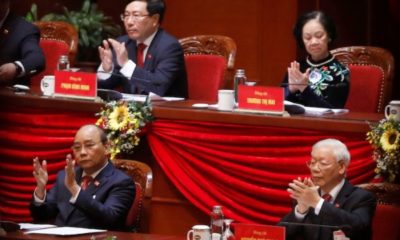
 Politics & Economy4 years ago
Politics & Economy4 years agoVietnam’s unresolved leadership question
-
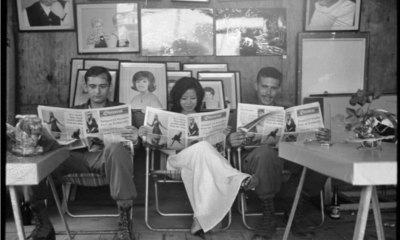
 Politics & Economy2 years ago
Politics & Economy2 years agoRethinking History and News Media in South Vietnam
-
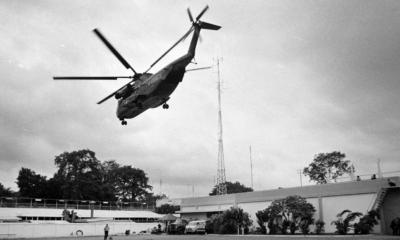
 After 19751 year ago
After 19751 year ago“The Vietnam War Was an Unwinnable War”: On Factuality and Orthodoxy
-
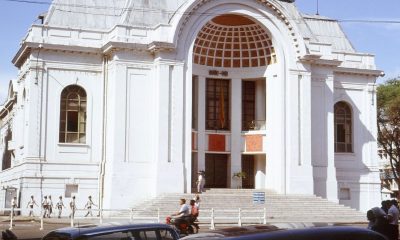
 ARCHIVES5 years ago
ARCHIVES5 years agoDemocracy in action: The 1970 Senatorial elections in the Republic of Vietnam (Part 1)
-

 Society & Culture5 years ago
Society & Culture5 years agoPandemics and Morality: Lessons from Hanoi
-

 Politics & Economy4 years ago
Politics & Economy4 years agoThe Limit to U.S.-Vietnam Security Cooperation
-
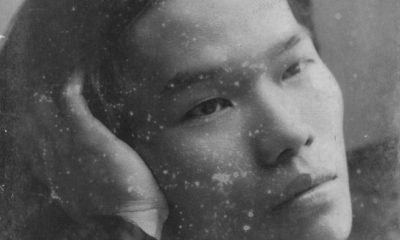
 Politics & Economy5 years ago
Politics & Economy5 years agoNational Shame: How We (Americans) can learn from Nguyễn An Ninh
-
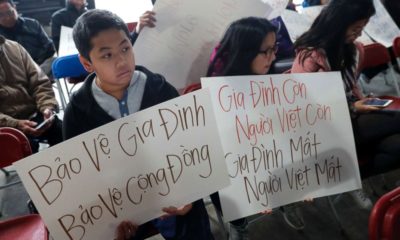
 Vietnamese-America4 years ago
Vietnamese-America4 years agoDeporting Vietnamese Refugees: Politics and Policy from Bush to Biden (Part 1)


